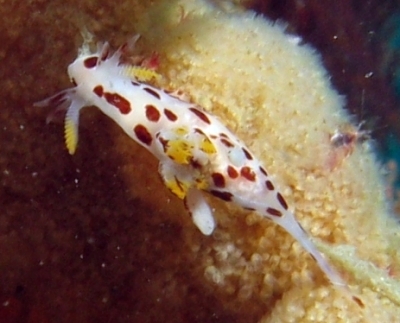
Ancula sp. 1
Order: NUDIBRANCHIA
Suborder: DORIDINA
Superfamily: ANADORIDOIDEA
Family: Goniodorididae
DISTRIBUTION
Known only from Sth Africa
PHOTO
Locality: Hout Bay, 20m, Cape Town, Atlantic Ocean, 11 February 2006, Wreck. Length: 4cm and 2cm. Photographer: Wilhelm van Zyl.
This species has been reported previously from South Africa (Gosliner, 1987; sp. 165 - as Ancula sp. 1). The colour pattern appears to be very distinctive. It is reported here to feed on kamptozoans [message #19307]
-
Gosliner, T. M. (1987) Nudibranchs of Southern Africa, a guide to the Opisthobranchs of southern Africa. Monterey, Sea Challengers. 1-136.
Rudman, W.B., 2007 (January 23) Ancula sp. 1 [In] Sea Slug Forum. Australian Museum, Sydney. Available from http://www.seaslugforum.net/find/ancusp1
Related messages
Feeding Ancula sp. from South Africa
January 24, 2007
From: Wilhelm van Zyl

Dear Bill,
I spotted this 'family' of nudibranchs on the wreck of the Aster in Hout Bay near Cape Town. I am quite sure from Terry Gosliner's book that this is his Ancula sp. 1 which I could not find on the Forum. (Maybe under a new name?). I have also seen an animal [message #19305] on the same dive, which I thought was the same species. After re-examining the photos I have concluded that this might be Thecacera pennigera? The rhinophores are orange, the spots are darker and more rounded and the papillae next to the gills are more orange than in the Ancula sp.
Regards
Wilhelm
Locality: Hout Bay, 20m, Cape Town, Atlantic Ocean, 11 February 2006, Wreck. Length: 4cm and 2cm. Photographer: Wilhelm van Zyl.
diving@cyberdale.co.za



Dear Wilhelm,
Thanks for another interesting message. Yeas this is definitely Terry's Ancula sp. 1. I'm pretty sure it has not been named as yet. Of particular interest is why the large animal and the smaller ones are all aggregated together. From you whole photo - which I haven't included - they are on a large sponge colony, but as you can see in these close-ups, the whole sponge is covered with a closely packed colony of kamptozoa. Have a look at the Fact Sheet I have recently prepared on these strange little animals, which are the sole food item of the related nudibranch genera Trapania. Your photo is very interesting, because we have no good evidence on just what the food of Ancula is. Ancula gibbosa is said to feed on compound ascidians, but Bernard Picton thinks they may feed on kamptozoa. Your photo is pretty strong evidence that this South African species definitely feeds on kamptozoans
Now to the animal [middle right photo] from your earlier message. It is indeed Thecacera penngera. Apart from colour differences the two genera differ in the decoration around the rhinophores. In Ancula there is a bifid papilla on the outside of each rhinophore stalk while in Thecacera there is a large rounded cup. Now that we know about the food of Ancula and easy field clue to which is which would be to note where they are found. Species of Thecacera, like species of Polycera, feed on bryozoans, so are likely to be found wit other polycerids. On the other hand, Ancula is likely to be found on sponges, or some other place where kamptozoans can be found. Not that useful if you find one crawling across a rock, but both polycerids and goniodorids are often found on their food.
Best wishes
Bill Rudman
